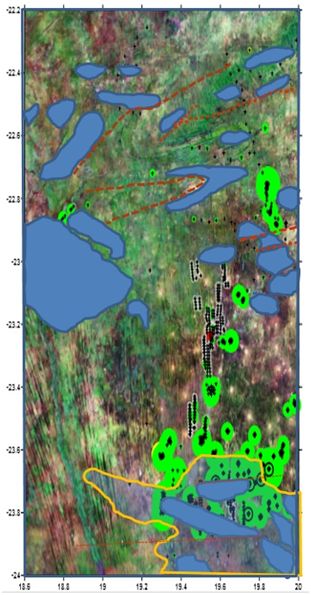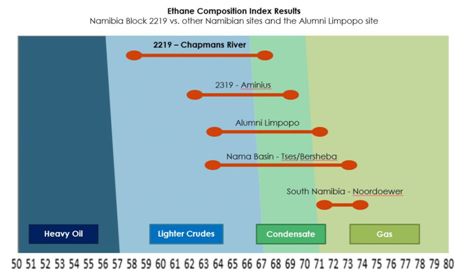Geochemical Sampling
Hydrocarbon micro-seepages can be picked up in the earth’s soil and used as an important indicator of subsurface oil reserves. Geochemical surveying is the process of collecting and analysing surface soil samples in a designated area. Analysis of the surface samples is performed to look for surface anomalies, areas where there is a high level of hydrocarbon micro-seepage.

Geochemical test results and anomalies from a geochemical survey conducted on the Namibian concession
If they exist on a particular surveying area, the shape of the anomalies can be used to identify the hydrocarbon source. Once again geochemical anomalies only show the end point of a seepage route, which can be directly above hydrocarbon deposits in areas with simple geological features, or in more complex geologies, up to 100 km away from the deposit where transverse seepage has occurred.
What is important however, is that as well as providing a good indication of the existence of hydrocarbon deposits (and coupled with an understanding of the underlying geology, an indication of the location of the oil deposits) geochemical samples provide an understanding of the hydrocarbon source composition.
Over the last 5 years ANE has been conducting geochemical surveys of our Namibian concession. We employed Geofrontiers, a Texas based geochemical exploration company, to collect and analyse soil samples on our two concessions. Using acid extraction techniques, the presence of methane (natural gas) to butane (liquefied petroleum gas) hydrocarbons was investigated. Their report found significant concentrations of these paraffins at several regions on the concession. The green up patches in figure 10 are anomalies which have been identified to have 100 times the background concentration.
In a second round of tests, the ratio of methane to ethane and propane (called the ethane composition index) was examined to better understand the seepage source of the micro-seepages.
These second tests were performed at sample areas with particularly high concentrations on the concession. The ratios indicate that the hydrocarbons were produced by a thermogenic process (high temperatures at great depths) rather than through the biogenic processes which can create them at the surface. In addition, these ratios indicate that light crude is the most likely source from which the paraffins migrated to the surface – See “2319 – Aminius” in the image below.

Ratio of methane to ethane and propane – An indicator of the seepage source